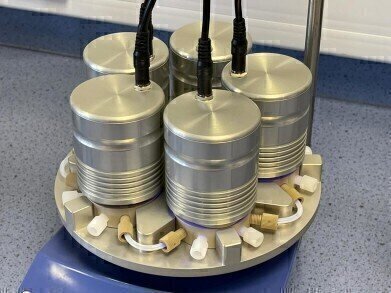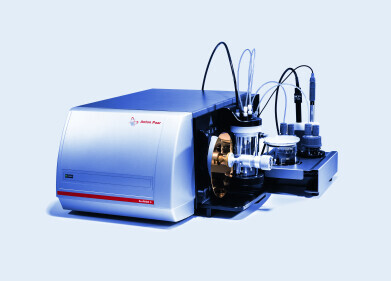-
 An Asynt fReactor Photo Flow with 5 modules set-up on a hotplate stirrer.
An Asynt fReactor Photo Flow with 5 modules set-up on a hotplate stirrer. -
 Professor Nikil Kapur of the University of Leeds examining fReactor Photo Flow modules.
Professor Nikil Kapur of the University of Leeds examining fReactor Photo Flow modules.
Laboratory Products
Powerful Platform for Photochemistry in Flow
Sep 03 2021
What are the benefits and drawbacks of photocatalysis?
Photocatalysis is an important synthetic tool for providing access to reaction pathways which would normally prove problematic or require multi-step synthetic routes using classical thermal or chemical activation methods. However, until now, synthetic organic chemists have shied away from photochemistry because of safety concerns around ionising UV light, and overly complex equipment.
Easy-to-use platform with high operational safety
To address this problem, Asynt, in conjunction with the University of Leeds, has developed the fReactor Photo Flow, an easy-to-use, yet powerful platform for scientists looking to explore photochemistry in Flow Chemistry applications.
Specifically designed for ease of use and high operational safety, the fReactor Photo Flow delivers all the key advantages of flow photochemical reactors, over conventional batch systems, including consistent light flux, controlled exposure times and precise temperature control.
This new addition to the Asynt fReactor Flow Chemistry platform has been launched with two high power LED wavelengths options (450nm/Blue and 365nm/UV) to suit most photochemical activation requirements. Alternative excitation wavelength options are available upon request.
Asynt's popular fReactor platform offers chemists an affordable entry point into the world of Flow Chemistry. Integrating the efficiency of pipe-flow processing with the advanced mixing of 5 Continuous Stirred Tank Reactors (CSTR), fReactor delivers a versatile ‘plug-and-flow’ setup which is well-suited to multiphasic reactions allowing chemists to explore continuous-flow processing with ease.
Installation of each fReactor Photo Flow module is exceptionally straight forward. By placing the module over the required fReactor cell, the Photo Flow simply clips quickly into position ready for you to start your experiment. Designed for flexibility, you can choose how many Photo Flow modules to use on a fReactor base platform, from one to five. All five fReactor Photo Flow modules can be powered from a single power supply using an optional splitter lead.
To view PowerPoint slides from the recent ‘Unlocking Photochemistry in Flow’ on-demand webinar please visit
More information online
Digital Edition
Lab Asia 31.2 April 2024
April 2024
In This Edition Chromatography Articles - Approaches to troubleshooting an SPE method for the analysis of oligonucleotides (pt i) - High-precision liquid flow processes demand full fluidic c...
View all digital editions
Events
Apr 25 2024 Istanbul, Turkey
Apr 28 2024 Montreal, Quebec, Canada
May 05 2024 Seville, Spain
InformEx Zone at CPhl North America
May 07 2024 Pennsylvania, PA, USA
May 14 2024 Oklahoma City, OK, USA
.jpg)
















